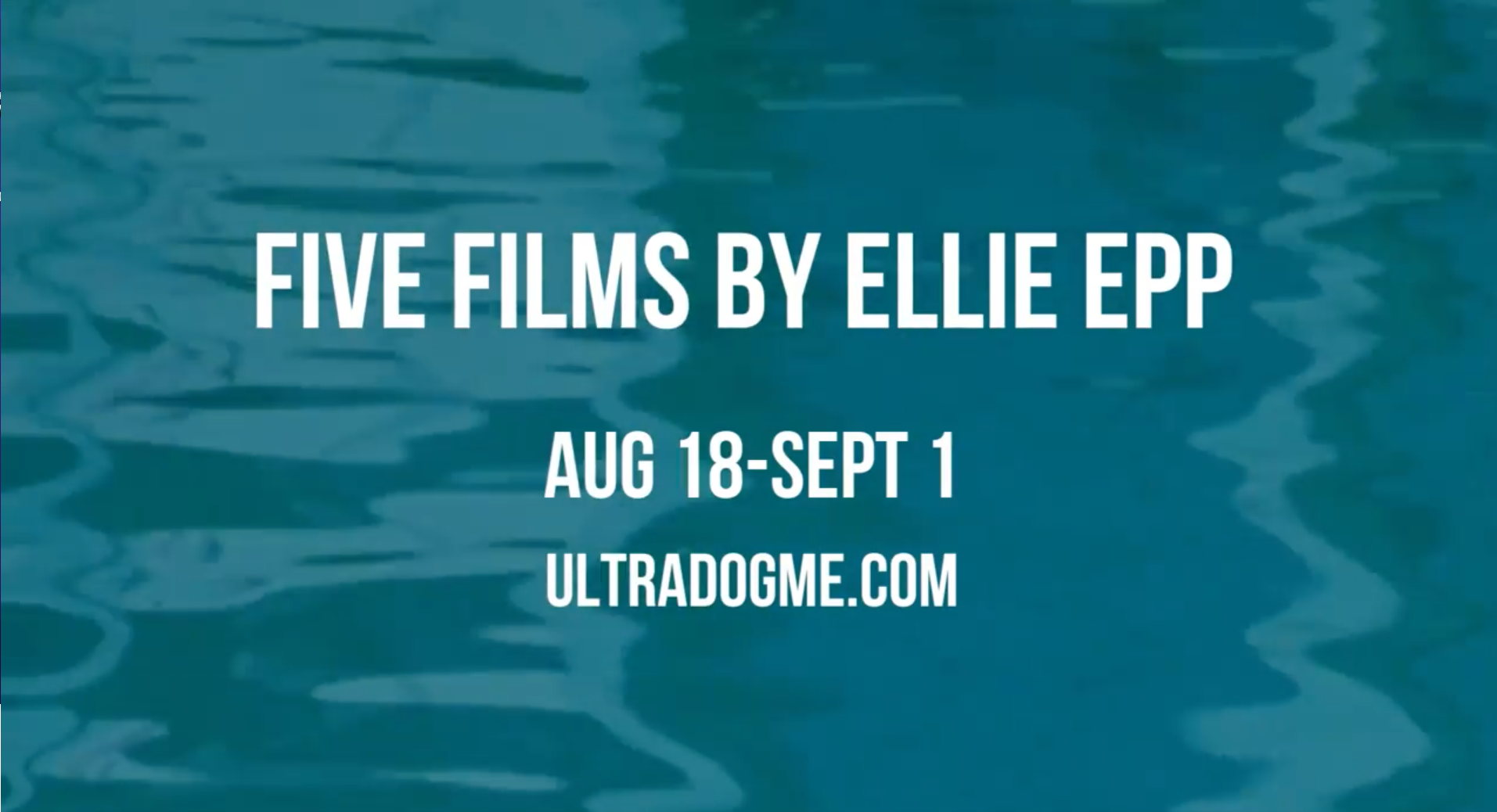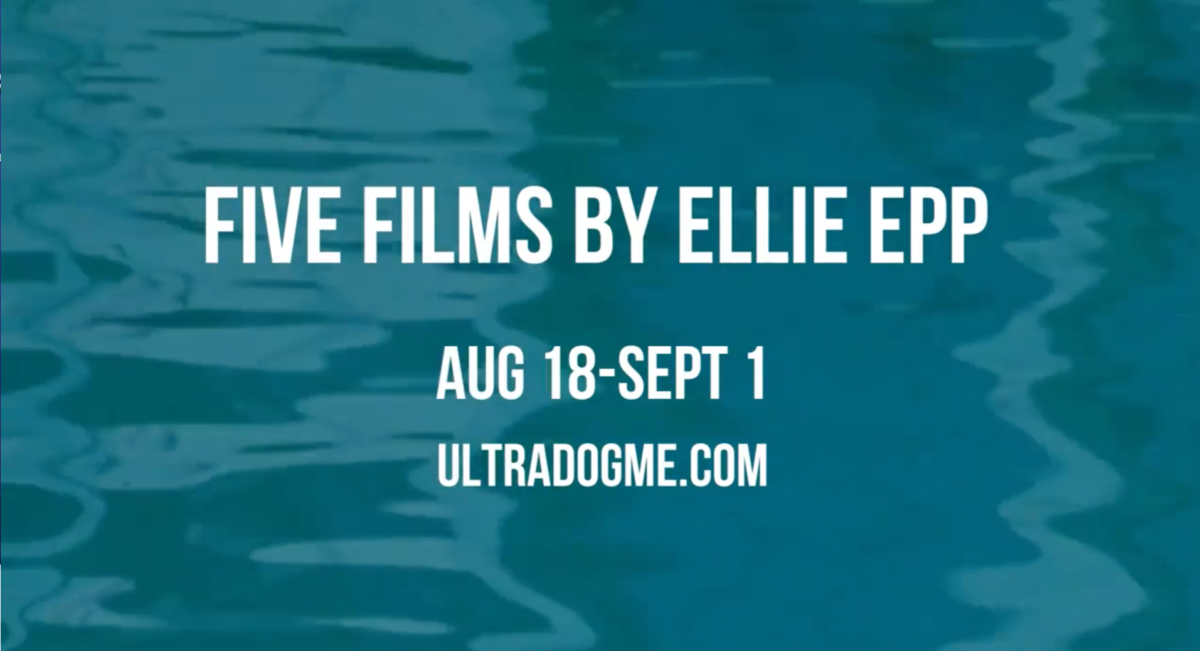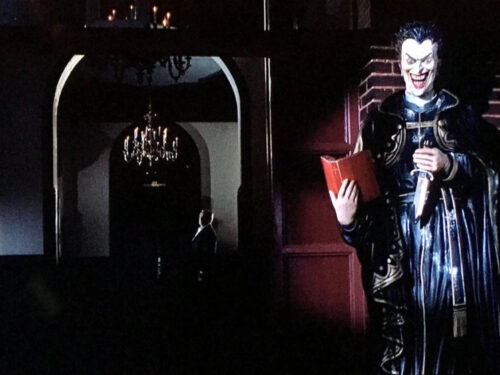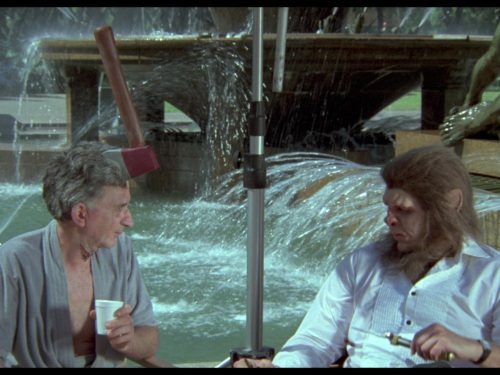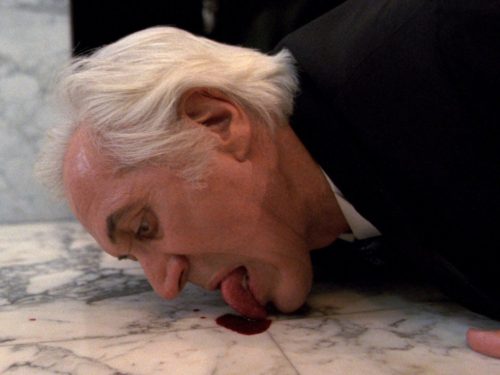Ultra Dogme’s latest program, Five Films by Ellie Epp, spotlights an under-screened filmmaker who deftly blends traditions in channeling the almost mystical power of her medium. It is available to stream for free until Sept. 1
If you don’t live in New York with the income and free time for regular filmgoing or call the academic world your home, it’s typically a rare treat when you can discover a previously unknown master working outside the established cinematic canon. That is, of course, unless you’re a regular visitor to Ultra Dogme or, better, a Patreon subscriber. Through their first year of hosting a Movie Club, Ultra Dogme’s trio of co-founders have presented programs of films from directors including Gautam Valluri, Lee Jangwook, Blanca García, and the legendary Larry Gottheim. I consider myself to have had a more than adequate education in experimental cinema; nevertheless, Ultra Dogme’s programming continually challenges and surprises. Their curation constitutes a genuine public service.
Film lovers everywhere can stream their latest program, a five-film overview of Canadian multi-disciplinary artist Ellie Epp’s career1, for free. Those who do will get a too-rare look at a filmmaker who demands closer attention. With no selection counting more than 100 views on Letterboxd, it’s fair to say the program shines a light on some of the great underseen experimental films. In presenting the majority of Epp’s published film catalog, Ultra Dogme makes an emphatic argument for her place among the medium’s great visionaries.
Related: Northern Light: A Sampler Of Canadian Underground Film by Stephen Broomer of Black Zero
Over less than an hour, Five Films by Ellie Epp provides a kind of biography of its central figure and a thorough education in popular traditions of experimental film. Without dry lectures, Epp wrestles with the capabilities of cinema and the shortcomings of typical techniques, both mainstream and avant-garde. Conversations with Epp reveal her close study of many classics as well as a seemingly instinctual understanding of how to simultaneously, provocatively play upon and subvert convention. trapline, a film Epp describes as “a battle between structuralism and beauty,” is only the most obvious example. In that film, as in each subsequent film, one observes a series of harmonious paradoxes. Epp’s work is of its moment, yet cognizant of history; she luxuriates in celluloid’s pleasures, yet denies the payoffs of more conventional films; her films evince a singular, carefully considered point-of-view, yet showcase a supremely democratic approach to creation.
trapline (1975)

Ellie Epp made trapline, a masterpiece composed of 11 shots2, following a revelatory experience with a program of experimental films. One mid-length work especially thrilled Epp’s imagination and seemed to set a precedent for the kind of art she aspired to make:
“I saw Chantal Akerman’s Hotel Monterey [1972] and that was the one that lit the fuse. I saw what I wanted to do. It was the sense that you could use film to engineer a change in consciousness.”
Like Akerman, Epp knows that to observe is potentially an active process. More than mere spectators, careful film viewers participate in the act of creation through the assumptions and experiences they bring to a film, the sensory and emotional trials they undergo throughout it, and any conclusions they’re able to draw after the fact. When Epp discusses arriving at realizations about her films years after completing them, she implies the essential role that viewing and re-viewing play in bringing her work fully to life. Epp’s films and her comments on them find her, like Akerman, rejecting condescending ideas about the passive, receptive female gaze and experience. Writing about bright and dark, she describes her effort to evoke a sixth, distinctly erotic and, perhaps, uniquely feminine sense. Though she is describing one film, my favorite, she could be describing the authorial sensibility, probing and inviting, evident across the whole program:
“… when women’s eroticism is described as passive a stupid equation is being made between attention and passivity. Close attention is intensely active. Receiving a touch is as active as giving it — sometimes more active, more skilled and more consequential. Erotic attention isn’t an empty bowl touch is poured or pushed into; it is more like a living antenna with a million fibers actively searching the space of the touch.”
Though her filmography is, so far, far less broad than Akerman’s, it evinces a similarly broad directorial skill set and desire to explore the full possibilities of the medium. Hotel Monterey’s silent exploration of its title location situates the viewer in an almost purgatorial state. Rather than bring its subjects definitively to life, the addition of sound to trapline heightens the sense that we’re somewhere between the worlds of the living and dead, a plane only the camera’s aperture can open the door to.
In addition to suggesting the long history of her soon-to-be-demolished central location, a Victorian bath house repurposed as a public pool, Epp recalls and predicts the whole history of experimental filmmaking. What she calls a “battle” in fact finds structuralism and photography engaged in productive sparring. trapline is never purely observational or lyrical. There is, throughout, both a stark simplicity and a conscious effort to dazzle. Epp employs a mix of silent compositions and shots accompanied by rich, asynchronous soundscapes. Both types of shots prove haunting and haunted. Voices from the building’s long past seem to bounce off the walls and echo across the years and frames. The change of consciousness Epp engineers serves to place us in a uniquely cinematic position, unmoored from traditional notions of time and space. Zoomed perspectives often suspend us in impossible positions, floating just above the surface of the pool with our faces pressed against it as if against a window. Interceding stretches of black leader play an especially immersive role even as they offer the viewer a kind of reprieve. Accompanied at times by swimmers gulping in breath and once by the sound of a running shower, they prepare the viewer for what comes next. The film’s beautiful fifth and sixth shots capture reflected light in especially beguiling dances. Both sequences belie trapline’s humble setting without losing the film’s fundamental sense of degradation and loss. In the former, the ghostly light on the pool’s surface almost looks as if it aims to beautify the grimy tiles along its bottom. Epp manages all of this without noticeably moving the camera.
When the camera finally moves during the eighth shot, making a long, slow zoom into the building’s paned ceiling, it’s like an even shorter, no less impressive, version of WVLNT (2003). Epp presents a miniature narrative, somehow massive in its revelations about the film’s diffuse yet unified perspective. Epp’s camera reflects her own intensely perceptive point of view. It takes one of the most natural camera-wielding urges, to look upward, to its logical apotheosis. As the zoom inches closer to the glass, the shot compels even deeper contemplation than the long-shot compositions preceding it. It recalibrates the viewers concentration in anticipation of the final trio of images. As if the zoom pulled us to the surface, we close the film focused squarely on life outside of the pool. Swimmers make only the faintest impression over this final set of compositions. In the penultimate shot, splashes barely make their way into the bottom of the frame. trapline’s silent final shot splits the frame between an unseen figure, changing behind a curtain, and a group of boys sitting and talking in a large shower stall. A final structural joke draws the film to a close, the unseen swimmer’s shorts hit the ground just as the curtain drops on trapline.
current (1986)

Produced in 1978 and released years later, current is one of two silent films in Ultra Dogme’s program and alone among the selections in pairing silence with pure abstraction. Shimmering, vertical beams of blue light grow brighter and fade, drawing the eye from left to right and back again. Just as the film’s rhythms threaten to grow familiar, current gains a second wind and enters a new, more dynamic movement. It is as if an unseen bather has suddenly kicked and caused new ripples, new currents, in its surface.
However resplendent and nearly supernatural its imagery, current retains its own formal rigor. Though nobody would call it a structural film, a sense of authorial control permeates its brief runtime. If this is improvisation, it is akin to the improvisation of a practiced jazz musician. If I have a gripe about current, it’s that learning how it was made saps some of its mysterious appeal. Seeing it without an explanation was tantamount to experiencing an entirely new kind of image. On rewatch, armed with the insights necessary to mentally reconstruct its construction, current still impresses, but loses some of its ability to hypnotize.
Would I say the same thing about Mothlight (1963), Commingled Containers (1997), or Chinese Series (2003)? Certainly not. The latter two in particular grow all the more poignant when the viewer can contextualize them within Stan Brakhage’s life and career. Perhaps my slight dejection is a testament to how genuinely otherworldly current’s ineffable imagery is. Learning that Epp conjured something like heavenly harp strings or the curtain-like ripples of the Northern Lights from blinds captured on Tungsten stock, which shines blue in daylight, struck me as both revelatory and a little anticlimactic. Sure, we’re being let in on a secret, but we’re also getting a reminder that magic isn’t real. The film, despite my complaints, never grows old. Even once its mysteries are explained, it still offers truly one-of-a-kind images and invites attempts to read between its luminescent lines.
notes in origin (1987)

Epp’s respect for celluloid comes across in her characterization of notes in origin. The film we can stream, she suggests, is merely a passable substitute for the record of this period in her life in its truest form: a pile of 100-foot film reels. One imagines that Epp’s preferred method of experiencing the imagery would be to first see the accumulated film stock and then attend one of the live multimedia performances in which she narrativizes the material. She calls the completed film, just over 15 minutes long, a compromise. In its current “compromised” state, notes in origin still includes many of the program’s most potent examples of Epp’s particular gaze, which finds the ecstatic in paying close attention to one’s subject matter. The assorted scenes, all captured in Epp’s native Northern Alberta and varying in length from a few minutes to a few seconds, seem filled to bursting with evidence of their director’s personal history and feelings of elation upon returning. Avoiding bucolic clichés — we don’t see any passively grazing livestock or hardy laborers, the weather seems mostly uninviting — Epp still leaves no mistake as to why she considered the place paradise.
The film’s first few frames best communicate the agitated stillness of Epp’s images. For nearly a minute we can’t know for sure whether the first shot, a swan floating on an icy pond, is a still image or not. For many charged seconds, the only visible motion is the camera’s almost imperceptible tremors and shudders. Viewers can only perceive these subtle signs of life by repaying the close attention Epp affords her subjects. It’s easy to miss the swan’s neck craning, too; the almost-jerky movements that briefly raise the possibility that Epp has decided to playfully jump from frame to frame and create a celluloid flip book. Epp’s subsequent shot does stage a kind of structural trick, condensing the moon’s movement across the sky to the length of a two-and-a-half-minute reel.
Per Epp’s description, the numbered frames that introduce each new composition were a concession to literary tradition. notes in origin is, however, distinctly cinematic (in this form, at least) even after it abandons tricks like this for more static tableaus. In addition to its obvious aesthetic appeal, Shot No. 3 gifts a rich metaphor for the psychic journey notes in origin, its predecessors, and its progenitors take viewers on. A sheet of fog, thin and low to the ground, carries us deeper into the haze of memory while unclouding our vision in a deeper sense. Like a pared-down version of Gottheim’s Fog Line (1970), it plays as a useful representation of the enlightening experience that is exposure to critical cinema. More than perhaps any shot in Epp’s corpus, this one calls to mind the revelatory process of “crossing the threshold” and opening one’s eyes to film’s possibilities.
bright and dark (1996)

In a contradiction befitting the paradoxes and ironies of Epp’s work, bright and dark grows somehow more mysterious when you learn about how it was created. It attained its distinct look through an approach at once attentive and indifferent. Setting out to make a film about a sixth sense, which she would come to call “electric touch,” Epp wound up leaving a roll of film in the trunk of her car for months. In its partially developed emulsion, the film retains some semblance of the people and experiences it never captured.
The film’s images occupy an in-between state and are nevertheless as complete as cinematic images get. Epp’s celluloid is just half-developed and still, within seconds, suggestive of not just a lifetime of love, but the full history of love. It is among an incredibly small handful of films that feel fated to exist. Epp’s reverence for cinema’s fundamental elements confirm that she would never wantonly neglect hundreds of feet of film. In leaving it unattended, Epp, consciously or unconsciously, embraced a process of directing through receiving rather than touching. Far more effectively than many filmmakers who’ve consciously sought to capture rituals or edit together incantations, Epp enacts a rite simply by exposing film to the elements and priming the chemical processes that lead to motion photography.
In Epp’s words, the film grain takes the form of “big cellular-looking clumps” that “squirm biologically” as they pass before our eyes at 24 frames per second. Epp’s description of the roiling and pulsing film grain nearly personifies bright and dark without a whiff of sentimentality. These films are not offspring, they are merely other living, breathing creatures composed of cells and containing enigmatic depths. The cinematic apparatus and the body become one. Epp likens closing and opening the lens to inhaling and exhaling and speaks to the accumulated secrets hidden within the filmstrip’s photochemical layers.
Epp soundtracks the film with what she calls “short stories about electric touch,” both personal and, in German, quoted from Medieval mystic Mechtild von Magdebourg. Without cheapening the impossible beauty of what we’re seeing, they perfectly put it into words. Ultimately, the final line of narration best articulates bright and dark’s place between undeveloped celluloid and the captured image and most calls to mind Epp’s comments on active, erotic attention:
“The art she sought was not a communication but a reception as the sun shines into water and yet leaves the water undisturbed.”
The narrator could be describing the effect Epp captures with many of trapline or notes in origin’s shots too. You could read it as a thesis statement for Epp’s filmography as a whole.
Epp’s characterization of her own process tends toward the almost mystical and even a skeptic like me can’t help but feel spellbound. To watch bright and dark in particular is to experience its medium at its most awe-striking, to feel both empowered and reduced. Epp understands the beauty inherent in the very material of film as well as its capacity for making the ephemeral tangible, for not just bringing dreams and memories into the real world, but, to paraphrase her, for ushering viewers into entirely thrilling new states of consciousness. I wish I could hold a print of it in my hands.
last light (2015)
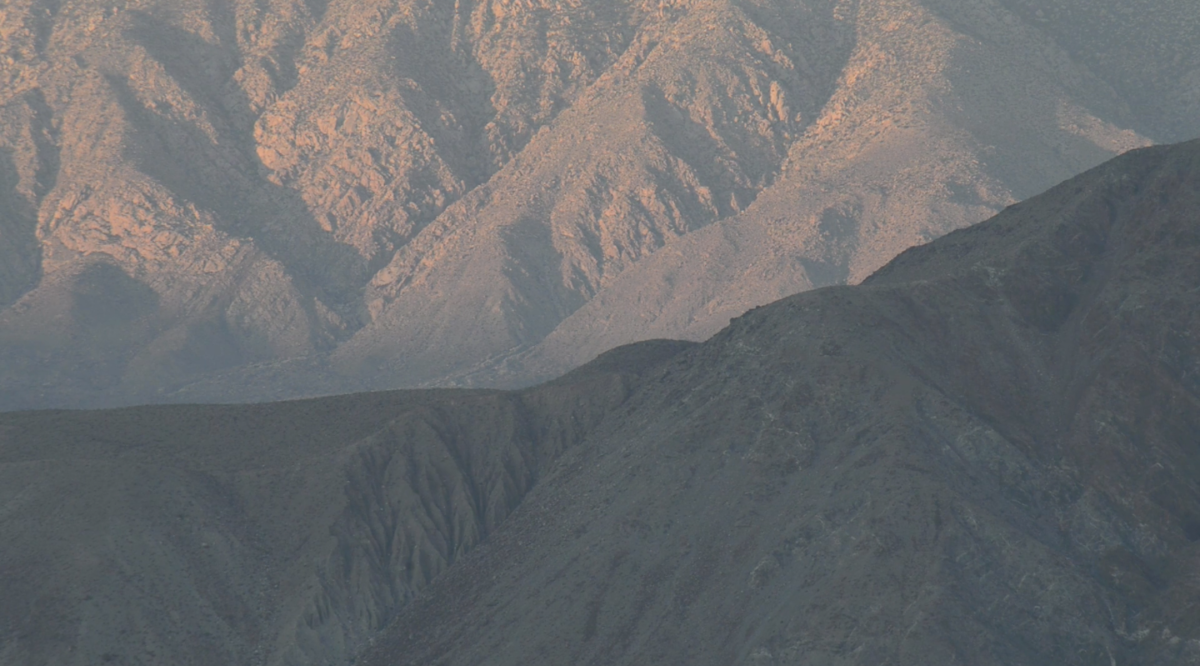
Epp returned to filmmaking after a decades-long hiatus3 with the landscape film last light. It appears to inform a new chapter in her career. It has been followed by a number of superficially similar films, static observations of nature. Other studies of changing light like James Benning’s epic-length Nightfall (2012) have a more durational nature. In addition to asking viewers to pay closer attention than usual, watch out for subtle shifts and finer details, they push the limits of conventional runtime and demand stamina from their audiences. In a conversation with Mike Hoolboom, Epp calls duration “the central sophistication of experimental filmmakers” and implies the crucial role endurance, a comfort with durational filmmaking, plays for filmgoers. Her own lesson in the potential power of duration, thanks to Hotel Monterey, sounds exciting. She uses the word “ecstatic” and likens it to crossing a threshold. We can infer, however, that Epp is perhaps wary of exhausting viewers in her efforts to reframe and recontextualize consciousness. Though this digital film could not have presented the same material roadblocks as Epp’s earlier efforts, she retains her economical approach. While last light’s single shot lasts longer than any isolated frame from any of Epp’s previous films, it welcomes the viewer rather than overwhelming them. Its straight-ahead gaze even allows us to stare imposing hills in the face rather than straining our necks and eyes to look up at them.
Though there is almost a sense of modesty in Epp’s decision to avoid pushing certain limits of landscape film, last light is grandiose in other respects. Just as much as trapline, this film is aware of the power of its location and is open to the possibility of collaboration by way of channeled energy and history.
Epp’s films have never lacked potential visual metaphors. In trapline, when an offscreen swimmer takes in a sharp breath over black leader, they breathe life into the film and offer an explanation for the way rippling pool water recalls filling and emptying lungs. The larger scope and scale of last light takes this element of her work to another level. Epp attends to the cinematic qualities of the camera’s surroundings, turning the setting sun into a lens cap or a falling curtain. Though Epp describes the importance of entering into a relationship with whatever her fixed frame captures and paying complete attention, she remains open to unexpected changes. When birds cut across the frame or dance mid-air in the growing dark, Epp reveals an appreciation for the unpredictable and a desire to broaden her light study into a life study.
In an interview with Corinne Cantrill, Epp describes her life and photography around the time she shot the rolls of film that would become notes in origin:
“I was living alone in a farmhouse most of the time. I was constantly amazed at how dark it could be and you could still take pictures.”
The closing stretch of last light looks like an attempt to restage these experiments in solitary late-night photography. Epp allows us to share a unique visual experience, watching as a camera strains like a squinting eye to catch a final glimpse of the disappearing horizon.
Stream Five Films by Ellie Epp on Ultra Dogme Aug. 18-Sept. 1:
Stay up to date with all things Split Tooth Media and follow Bennett on Letterboxd
(Split Tooth may earn a commission from purchases made through affiliate links on our site.)
- This monograph on Ellie Epp, edited by Mike Hoolboom, was essential to my immersion in Epp’s work. In addition to interviews with Hoolboom and others, it includes writing from Epp ranging from transcribed lectures to poetry.
- Most everything you’ll read says 12, but unless you count the opening title card (Bart Testa and Chris Kennedy definitely don’t include it in their summaries), I don’t know how you arrive at this number. Paul Grant includes the first instance of black leader in his count, describes the film as consisting of “twelve individual takes,” and goes on to detail frames including Shots 13, 15, and 17. Here’s my version of a quick shot-by-shot summary without the title card: Shot No. 1 (by every count I’ve seen besides Grant’s) shows the paned ceiling reflected in the pool and tiled swimming lanes along its bottom; Shot No. 2 shows part of the ceiling reflected in the pool; Shot No. 3 shows pool tiles distorted by rippling water and the shadow of a passing figure; Shot No. 4 (which Testa numbers 5) shows several children swimming across the frame; Shot No. 5 shows more reflected windows and rippling tiles oriented in such a way that columns of white and blue seem to point toward us; Shot No. 6 shows grimy pool-bottom tiles and a beautifully purling reflection; Shot No. 7 shows unidentifiable objects in close-up; Shot No. 8 shows the building’s elaborately paned glass ceiling and slowly zooms in; Shot No. 9 shows a trio of empty shower stalls; Shot No. 10 shows a wooden staircase as unseen swimmers send up splashes in the foreground; Shot No. 11 shows a figure changing behind a curtain as three boys sit and silently converse in a large shower stall on the opposite side of the frame.
- Though Epp’s Vimeo account shows a gap between the release of bright and dark and last light, the intervening years were hardly a fallow period for the artist. In addition to earning a PhD and teaching at Goddard College, Epp found recognition as a garden designer while continuing to both shoot photographs and produce experimental writing. Hoolboom’s monograph also includes details on an in-progress video work, we made this.

